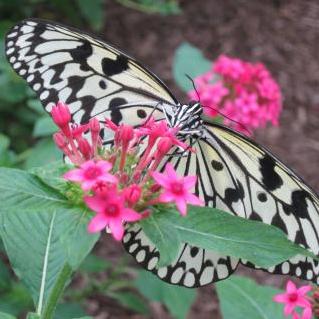
Feeding Backyard Songbirds
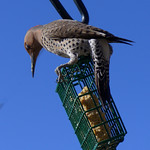
Attracting birds to your backyard is an enjoyable pastime. One learns quickly not all songbirds are alike. Part of the fun is identifying different species and their habits. Guidebooks and apps help with identification. A good guide illustrates plumage of males, females, and juveniles, and distribution maps to narrow your options.
- An excellent on-line resource is the Cornell Lab of Ornithology’s “All About Birds” website.
- The Arkansas Game and Fish Commission offers a free bird identification booklet called Arkansas Backyard Birds. Download a copy, or pick up a printed copy at their regional offices, state office, or nature centers. Wings Over Arkansas program rewards levels of achievement for bird identification.
- Birders who participate in the annual Christmas Bird Count and the Great Backyard Bird Count in February help scientists learn about trends in bird populations. According to The Audubon Society, the Christmas Bird Count is the longest-running community science bird project in the nation.
Studies indicate songbird populations are unaffected by availability of feeders for survival. However, once feeding starts in winter months, individual songbirds can become dependent on feeding stations, especially during inclement weather. If you start feeding birds in winter, continue to do so until native seeds and insects become available. Consider discontinuing feeding during other times when natural foods are available to reduce the risk of disease transmission between birds. Disinfect feeders regularly, and scatter accumulated hulls and bird droppings under feeders to facilitate decomposition and break disease cycles.
Best Bird Feeders

Bird feeders need to keep food fresh, dry, and accessible to birds while minimizing disease transfer and unwanted guests, such as grackles, squirrels and raccoons. Some sugar-water feeders are designed to minimize bees, wasps, and ants, which can drive away hummingbirds or others you wish to attract. The feeder should also be easy to clean frequently to keep birds healthy and prevent disease spread.
Determining the best design for a bird feeder depends on the type of birds you want to attract.
- Seed-feeding birds: Platform or shelf feeders are recommended to reduce the risk of birds passing diseases. To avoid larger, nuisance bird species such as grackles or blue jays, use lighter feeders designed for smaller birds which spin or tip when larger birds attempt to perch. Avoid feeders in which birds place their head inside a hole to retrieve a seed. Avian eye diseases can be transmitted when an infected bird touches the surface and the infectious agent is passed to another bird using the same hole.
- Suet-feeding birds: Hang suet (beef fat) from a wire cage to attract woodpeckers and other birds. Wire cages can be homemade or purchased. Suet feeders are best in colder or freezing temperatures, as fat tends to melt when warmer. Raw suet will turn rancid in warmer temperatures.
- Nectar-feeding birds: Although plastic dispensers are lighter, some prefer glass for its durability and ease of cleaning. Feeders with longer portals will prevent bees and wasps from gaining access, or purchase bee guards if this becomes a problem. Avoid feeders with yellow colors as these attract competing insects. For dissuading ants, either move the feeder, or apply frequently a small amount of petroleum jelly where mounted farthest from the feeder. Petroleum jelly and other sticky substances may cause bird feathers to stick together, so place substance in small amounts where birds are unlikely to come in contact. Since hummingbirds and other songbirds consume insects, using pesticides is not recommended.
- Insect-feeding birds: live or dried mealworms are consumed by bluebirds and other species. They should be kept dry to prevent mold and decay. While having drain holes is recommended in most feeders, live mealworms may wriggle through and holes should be plugged up. Such feeders need to be cleaned frequently and decaying worms disposed of, to prevent bird-borne diseases.
- Ground-feeding birds: Because some bird species feed exclusively on the ground, lightly scattered seeds such as white proso millet and black-oil sunflower may attract juncos, native sparrows, bobwhites, and wild turkey. Seeds can also be placed in a well-drained tray. Do not pile seeds, as mold and harmful bacteria may develop.
Where should I place my feeder?

- Feeders should be hung from fishing line or attached to poles with predator shields to prevent squirrels, raccoons, opossums, rats, and other animals from consuming bird feed.
- Feeders should be placed in an open area at least ten feet from surrounding trees, shrubs, or other concealing vegetation where predators may hide.
- Surrounding an open area where the feeder is placed, nearby trees, shepherd’s hooks, and fences can serve as perches where birds “line up” to quickly fly in, pick up a seed, and exit. Pine trees and shrubs offer escape cover when being pursued by a hawk or cat.
- Sometimes birds fly into windows resulting in injury or death. If this is a problem, consider placing your feeder at a different location, or reduce glare by placing objects on windows to make them more visible to birds.
Attracting Birds to Feeders
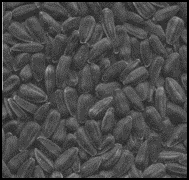
Common seeds and feeds
- Black-oil sunflower seeds: thin shells that are easy for seed-eating birds to crack open. Kernels have high fat content, which benefits winter birds.
- Striped sunflower seeds: thicker shell than the black-oil sunflower seed, which makes it difficult for some species to crack open.
- Shelled sunflower: option for apartment dwellers where shells are a problem. Attracts many birds, as well as squirrels. Can spoil quickly and harbor dangerous bacteria, so offer only enough than can be eaten in a day or two.
- Suet: hang suet (beef fat) from a wire cage with openings large enough for birds to peck through. Suet can be purchased at the local grocery butcher shop. Some commercially-available wire cages are designed to hold manufactured suet cakes oftentimes infused with seeds.

- White (proso) millet: a small white seed which is a favorite of ground feed birds and is usually scattered on the ground. If nuisance birds become a problem, switch to black oil sunflower.
- Milo (sorghum): a large and bulky seed which is less appealing to most bird species. Species known to consume milo are doves, wild turkeys, and cowbirds. Limit use if attracting too many cowbirds. Wasted seed, if left undisturbed, can lead to harmful bacteria and mold to grow and cause bird diseases.
- Sugar water: Mix one-fourth cup of granulated sugar to one cup water, and replace every 3 to 5 days (or every day or two in 90+ F degree weather) to prevent mold and deadly fermentation. Do not add red dye, and don’t substitute honey, which spoils faster and can cause growth of harmful bacteria. If making larger batches, heat sugar water and store excess in a refrigerator. Clean feeders at least once a week with hot water and a bottle brush. Do not use soap or detergent. Occasionally use dilute bleach solution to clean, then rinse thoroughly and air-dry before refilling.

Specialty seeds and feeds
- Safflower seeds: thick shell which is difficult for most birds to crack. Some sources indicate house sparrows, European starlings, and squirrels don’t like safflower, but in other areas, they are consumed by these species.
- Nyjer (thistle) seeds: As thistle is classified as invasive, suppliers use a daisy-like plant (Guizotia abyssinica) that produces a similar seed, which is heat-sterilized to limit risk of spread.
- Canola (rapeseed): compared to other seed types, only a limited number of birds consume rapeseed, such as bobwhites, doves, finches, and juncos. Other readily-available seeds are recommended which attract a wider variety of birds.
- Canary seed: species which consume canary seed are attracted to other readily-available seeds.

- Mealworms: Ways to keep live mealworms can be found at the Cornell Lab of Ornithology website. Dried mealworms are available as a chicken supplement at most farm supply stores. Birds which are unfamiliar with dried mealworms may need to be persuaded by moistening a couple initially. Otherwise, these need to be kept dry and offered in small amounts, as birds will gobble them up!
- Fruits: Because not many people use fruit feeders in our area, it can be difficult to entice birds. Also, fruits spoil quickly, so feeders need to be cleaned very frequently. Competing ants and wasps are attracted to fruit in the spring and summer; because native berries are available, feeding fruits is unnecessary during that time. In winter and spring, birds may be attracted to chunks of apples, melons, grapes, frozen berries, raisins or currants softened in water, and orange halves during spring migration.
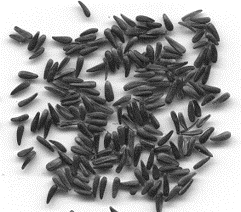
- Pumpkin or melon seeds: Bake seeds in the oven or spread them out to dry completely, then chop up in a food processor to make it easier for small birds to eat.
- Peanut butter: Best offered in winter when peanut butter is hardened. Use cornmeal or flour to reduce stickiness. Soft peanut butter can stick to birds’ mouths and transfer oil to their feathers. Avoid using in summer months when peanut butter oil can be transferred to eggs and plug the pores of shells which will kill developing embryos.
- Jelly: Offer only in very small quantities since jelly is sticky and can become sour in warm weather.
- Eggshells: Birds use grit and minerals found in chicken eggshells. Shells from hard-boiled eggs that have been sterilized are best. If eggshells are not cooked, bake for 20 minutes at 250 degrees Fahrenheit and let cool. Crush into pieces smaller than a dime and offer on the ground, in a dish, or a low platform feeder, separate from your seed feeder.

Seeds and feeds to AVOID
- Corn: Because harmful bacteria can grow on old corn, use only when fresh or not at all. Corn is the bird food most likely to be contaminated with aflatoxins, which are extremely toxic to birds even at low levels. According to the Cornell Lab of Ornithology, never buy corn in plastic bags, and never allow it to get wet. Never offer corn covered in a red dye. Corn and other seeds that have been dyed red are intended for planting and are often treated with fungicides, which are highly toxic to humans, livestock, and all birds.
- Peanuts: Because harmful bacteria can grow on old stale peanuts, use only when fresh or not at all. Peanuts can harbor aflatoxins, which are extremely toxic to birds even at low levels. Peanuts also attract squirrels, bears, raccoons, and other non-target species. Fresh peanuts in the shell can be set out on platform feeders for blue jays. If mixtures of peanuts and other seeds are offered, make sure to change the seed frequently, especially during rainy or humid weather.
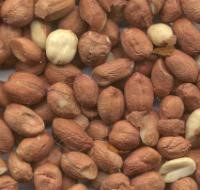
- Golden millet, red millet, flax, oats, wheat: these fillers can be found in packaged birdseed mixes, but most birds will not consume them. Left undisturbed, harmful bacteria and mold can grow on piles of waste seed, causing bird diseases.
- Leftovers: will attract less desirable species such as European starlings and house sparrows, as well as rats, mice and raccoons.
- Bacon drippings: can attract birds (and raccoons) but contain meat preservatives which are unhealthy for birds.
What Types of Birds Can I Attract?
Following are examples of types of birds which are attracted to different seeds and feeds.
| Type of feed | Examples of birds |
|---|---|
| Black oil sunflower seed | American crow, American goldfinch, blue jay, brown thrasher, brown-headed cowbird, Carolina chickadee, common grackle, dark-eyed junco, eastern towhee, house finch, house sparrow, mourning dove, northern cardinal, nuthatches, red-winged blackbird, tufted titmouse, white-crowned sparrow, white-throated sparrow, woodpeckers, quail and turkey |
| Black striped sunflower seed | American crow, blue jay, grosbeaks, woodpeckers, wild turkey |
| White proso millet | American crow, blue jay, bobwhite, cardinals, cowbirds, dark-eyed junco, doves, house sparrow, native sparrows, towhees, juncos, mourning dove, northern flicker, red-winged blackbird, song sparrow, white-crowned sparrow. |
| Safflower | Cardinal, some grosbeaks, chickadees, dark-eyed junco, doves, native sparrows, northern flicker & other woodpeckers, nuthatches, tufted titmouse, white-crowned sparrow |
| Nyjer | American goldfinch, bobwhite, towhees, chickadees, house finch, mourning dove, indigo bunting |
| Milo (sorghum) | Doves, wild turkey, and cowbirds |
| Fruits | American crow, American robin, northern cardinal, cedar waxwing, orioles, northern mockingbird, thrushes, bluebirds, mockingbirds, catbirds, tanagers |
| Nectar (sugar water) | Hummingbirds, orioles |
| Pumpkin or melon seeds | Blue jay, northern cardinal, possibly catbird |
| Suet | American crow, woodpeckers, northern mockingbird, nuthatches, chickadees, blue jay, starlings, tufted titmouse; occasionally wrens, creepers, some warblers |
| Jelly | Orioles, catbirds, and some warblers |
Preventing Disease Spread at Bird Feeders & Baths
Salmonellosis and other diseases can be transmitted between birds. Regularly clean feeders and bird baths once a week to prevent disease spread. Scrub baths and feeders inside and out with warm, soapy water and rinse thoroughly. Disinfect with a 10% bleach solution (9 parts water to 1 part bleach) either by soaking or spraying for 10 to 15 minutes. Rinse thoroughly and allow feeder to air dry completely. Make sure all bleach is removed as it could be harmful to birds. Use vinyl gloves and a mask for protection and to reduce disease transmission to yourself, as people are sometimes susceptible to these diseases. Thoroughly wash hands with soap and water when finished cleaning.
Discard any uneaten or contaminated seed in your compost bin or trash.
Sweep or rake piles of seed hulls and spread around for drying in sunlight. This is to prevent fungal growth and harborage of diseases.
To reduce the risk of disease transmission, and if cleaning feeders is a chore, consider landscaping your yard with native plants which produce seeds, berries, and nectar to attract birds.


Deer resistant plants
Few plants are deer proof, but some may be less appetizing.
See which plants deer don't like
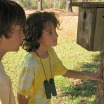
4-H WHEP Program
Youth learn about songbirds and other critters in the Arkansas Wildlife Habitat Education Program (WHEP).
Bird id, habitat, management, and more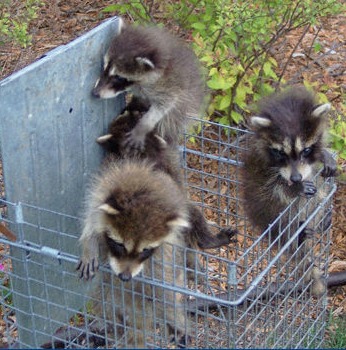
Critter problems?
Dealing with wildlife can be a challenge.
Wildlife problems in the garden and yardPublications
- 12 Wildlife Habitat Tips for Small Acreages
Many practices can be used to improve your property for songbirds and other wildlife.
- Electric fence designs for deterring white-tailed deer
Keep deer out of your garden with these simple to elaborate fence configurations.